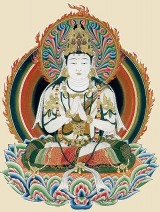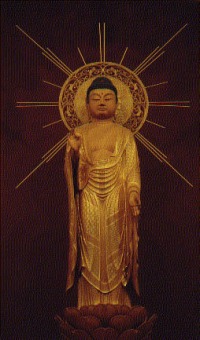Buddhism originated in India in the 500s. Siddharta Guatama founded it. Buddhism first appeared in Japan through gifts from Korean politicians. There were dozens of bronze and gold Buddhas. Buddhism was supported by Prince Shotoku, so it spread quickly. It had a powerful influence on Japanese culture. It consisted of the belief that one could gain happiness and peace by leading a life of virtue and wisdom. This appealed to many. Different forms, or sects, of Buddhism soon developed.
Tendai

Tendai Buddhism was brought to Japan from China by the Japanese monk, Saicho, in the eighth century. Tendai supported other Buddhist sects and the historical Japanese ancestral worship, Shinto. It focused on the intensive study of texts. This sect emphasized the learning of the Lotus Sutra (depicted on the left). The Lotus Sutra teaches ways to reach salvation through Buddha's lessons. One way was Srakakayan, which is the way of those who seek to become an arhat. An arhat is someone who has gained insight in the true nature of life and has reached nirvana, or spiritual enlightenment. Another path was Pratyeka-buddhayana, or the path of those who seek to attain salvation for only themselves. The last route was Bodhisattvayana, which is the way of those who postpone their own enlightenment to help others achieve it.
Shingon

Shingon Buddhism was attractive to those who appreciated its complex rituals. Unlike Tendai, it was founded in Japan by Kukai in 804 AD. Shingon practitioners believe that one could attain perfection while living in the present body. You didn't have to die to become perfect. There are three major forms practiced by them. Susokukan is the basic meditation to find one's breathing pace. Gachirinkan is the moon disc meditation. This meditation is completely visual. You have to imagine a seed that becomes a lotus, and out of the lotus come a moon disc. There are other variations of this. The final form is Ajikan, which is meditation on the form, sound and meaning of the syllable "A." In Shingon teachings, "A" is the a symbol of Dainichi Nyorai, the Supreme Buddha, who is the symbol of the ultimate reality. In fact, the syllable itself is called "the king of all mantras". Shingon followers believe that these forms allow one to experience many states of consciousness.
Shingon Buddhist monks in action
| shingon_monks.mov |
If you want to find out how to perform the Ajikan meditation, check out this document:
| the_practice_of_ajikan_meditation.doc |
Amida

Amida Buddhism, or Pure Land Buddhism, originated in India. It included the belief that people might have salvation in a pure land after death. The spread of Amida in Japan signaled a huge change in Japanese thought because the shift represented a shift from a religion which stressed individual effort aimed at enlightenment to an exclusive reliance on salvation by the Amida Buddha. Amida Buddhism was open to everyone, including women, who were previously excluded from other Buddhist schools. It also impacted the art of Japan. There were now animated artworks portraying scenes from the tortures of the ten levels of hell to the pleasures of Paradise. Some artworks also depicted the beauty of the Amida Buddha.
Zen

Zen Buddhism believed that something precious and divine exists in everyone. It put an emphasis on self-discipline, simplicity, and meditation. Zen followers believed that quiet reflection was better than Shingon's complicated ceremonies or Tendai's emphasis on scriptures. They focused on the individual's attempt to achieve inner peace rather than Amida's idea of salvation. This school of Buddhism impacted the culture of the Japanese the most. Zen Buddhism's emphasis on self-discipline could be viewed in Samurais, who thought it would help them on the battle field, and in today's Japanese workers. Also, people tolerated other religions because they realized that only their self-actualization would result in fulfillment, not their religious identity. Therefore, Christianity and other religions could thrive. Artists reflected Zen's simplicity and boldness by using only strong, dark, and black lines in their artwork.

